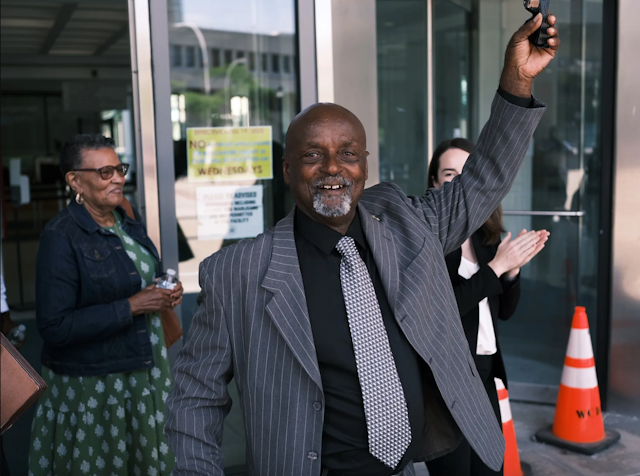In March 1976, American Leonard Mack was convicted of sexual assault and holding two female victims at gunpoint. In September 2023, Mack’s wrongful conviction was finally overturned by a New York judge on his 72nd birthday with the help of the Innocence Project, an organisation that uses DNA evidence to prove factual innocence.
Mack’s conviction took 47 years to overturn. He served seven-and-a-half of these years in a New York prison. His case is the longest in United States history to be overturned using DNA evidence.
In June 2023, a similar historic moment occurred in Australia. Kathleen Folbigg was pardoned and released after 20 years in prison for the murder and manslaughter of her four young children.
Considered one of the worst miscarriages of justice in Australian history, Folbigg’s release has sparked discussion over whether Australia needs a formalised body to deal with post-conviction appeals.
Read more: 'Serial' podcast's Adnan Syed has murder conviction vacated. How common are wrongful convictions?
Mack and Folbigg are only two individuals on different sides of the world who have spent decades fighting to prove their innocence.
Many others are still fighting. The prevalence of wrongful convictions is hard to determine. The National Registry of Exonerations in the United States has recorded 3,396 exonerations nation-wide since 1989.
But data on official exonerations fail to capture the many individuals whose convictions are yet to be overturned.
Estimates of the prevalence of wrongful convictions in the United States range from 0.5 to 5%. The exact prevalence in Australia is less clear but we do know 71 cases of wrongful convictions have been identified in Australia between 1922 to 2015.
Some have argued there could be 350 convictions per year of individuals who are factually innocent in Australia.
A witness mistakenly identifying an innocent suspect is common in many wrongful conviction cases.
Eyewitness misidentification is the leading contributing factor in wrongful convictions overturned by the Innocence Project, present in 64% of their successful cases.
In Australia, 6% of recorded wrongful convictions involved an eyewitness error.
This may be an underestimate given many applications to innocence initiatives in Australia alleging wrongful conviction, such as the Bridge of Hope Innocence Initiative, report eyewitness evidence as a potential contributing factor.
Read more: Kathleen Folbigg pardon shows Australia needs a dedicated body to investigate wrongful convictions
In Mack’s case, two victims misidentified him as the perpetrator. These identifications proved to be instrumental in his wrongful conviction. How did the two victims get it wrong?
How problematic procedures influence eyewitnesses
Eyewitness identification evidence relies on witnesses to accurately remember criminal perpetrators. Several factors affect eyewitness memory accuracy. Features of the crime can impact memory, such as whether it was light or dark, or whether the perpetrator wore a disguise.
Memory can also be affected by characteristics of the witness at the time of the crime, such as their stress or intoxication levels.
These factors are present at the time of the crime and cannot be changed. What is perhaps more crucial is that eyewitness memory can also be affected by the procedures law enforcement use to collect identification evidence.
In Mack’s case, there were serious problems with the procedures used to get the identifications from the victims. One of the victims made three separate identifications of Mack. Witnesses should only complete one identification procedure for each suspect, because the first identification will bias future identification attempts.

For two of the identifications the victim made, she was only shown Mack by himself surrounded by police. Showing a lone suspect without any other lineup members may increase mistaken identifications, particularly when the context in which they are shown is highly suggestive.
Seeing Mack in handcuffs and in the presence of police may have led the victim to identify him. Mack was the only person shown to the witness in these identification attempts, so the police officers organising the process knew he was the suspect.
“Single-blind” administration of identification procedures – where the police officers organising the lineup know who the suspect is – increase the likelihood of mistaken identifications.
For the other identification this victim made, she picked Mack out of a photo lineup containing seven images. Mack’s photo was the only photo in the lineup that contained visible clothing and the year (1975) in the background. All members of a lineup must be matched and no one lineup member should stand out, but Mack’s photo was distinct.
With all these problematic practices combined, we can see how Mack was misidentified and convicted.
In 2020, a team of eyewitness experts published nine evidence-based recommendations for conducting identification procedures.
These recommendations serve to reduce mistaken identifications and enhance accurate ones.
The recommendations address the problematic practices in Mack’s case, but also include things like making sure there is sufficient evidence to place a suspect in a lineup, and giving appropriate instructions to witnesses during the procedure.
Identification procedures should also be video recorded to identify any poor practices.
While these recommendations will go a long way to reducing wrongful convictions resulting from faulty eyewitness identifications, they will only be effective if followed by police.
The next step is ensuring these recommendations are embedded into everyday policing practice.

